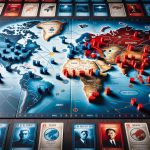If you’re a fan of board games and strategy, chances are you’ve heard of Board Game Geek. This online community is a hub for gamers to connect, share insights, and discuss their favorite games. One game that has garnered a lot of attention on Board Game Geek is Twilight Struggle, a two-player game that simulates the forty-five-year struggle between the US and the Soviet Union.
Twilight Struggle has gained popularity for its innovative gameplay and historical accuracy, making it a favorite among board game enthusiasts. As players delve into the complexities of this Cold War-era game, they often turn to Board Game Geek for advice, strategies, and discussions about mastering the game.
In this article, we will explore the strategic dynamics of the US in Twilight Struggle and delve into key tactics and tips for mastering the US strategy. Additionally, we will consider insights from top-ranked players on Board Game Geek and analyze popular US strategy variations in Twilight Struggle.
Whether you’re new to the game or an experienced player looking to elevate your skills, this article will provide valuable insights into the world of Twilight Struggle on Board Game Geek.
Overview of the Game Twilight Struggle
Twilight Struggle is a two-player board game that simulates the ideological, political, and military struggle between the United States and the Soviet Union during the Cold War era. The game was designed by Ananda Gupta and Jason Matthews and was first published in 2005. It has since gained a large following within the board gaming community, particularly on Board Game Geek, where it consistently ranks as one of the top strategy games.
The game is played on a world map divided into six regions: Europe, Asia, Middle East, Africa, Central America, and South America. Players take on the roles of either the United States or the Soviet Union and compete to spread their influence across these regions while avoiding nuclear war. Each player uses a deck of cards representing historical events and global developments to advance their agendas and thwart those of their opponent.
Twilight Struggle stands out for its deep strategic gameplay and historical accuracy. The game mechanics force players to make difficult decisions about when to prioritize expanding their influence or when to sacrifice short-term gains to prevent long-term disaster. These elements contribute to its popularity among enthusiasts of both board games and Cold War history.
One of the main appeals of Twilight Struggle is its high level of replayability. No two games are ever exactly alike due to the randomness introduced by the card drawing mechanic. This unpredictable element keeps even experienced players engaged as they adapt their strategies based on each new draw from the deck. As such, mastery of this complex yet deeply rewarding game can take time but proves immensely satisfying for those who invest in learning its intricacies.
History and Background of Twilight Struggle
Twilight Struggle, a board game designed by Ananda Gupta and Jason Matthews, is a two-player game that simulates the forty-five-year tug of war between the United States and the Soviet Union. Set in 1945 to 1989, players take on the roles of either US or USSR and strategically play cards to gain control of countries around the world, influence events, and avoid nuclear war.
The game has gained immense popularity among strategy enthusiasts and board game aficionados on platforms such as Board Game Geek.
Origins of Twilight Struggle
The concept for Twilight Struggle originated from a desire to create a historically accurate game that captured the tension and complexity of the Cold War era. Ananda Gupta and Jason Matthew’s shared passion for history and strategy games led them to collaborate on designing this multi-faceted game.
Gameplay Mechanics
The game mechanics of Twilight Struggle are heavily grounded in historical events, presenting players with challenging decisions that mirror actual dilemmas faced during the Cold War. Understanding the historical context is crucial for players looking to master the strategic intricacies of Twilight Struggle, making it more than just a typical board game but an educational experience as well.
The Strategic Dynamics of the US in Twilight Struggle
Twilight Struggle is a complex and deep strategy game that has gained a dedicated following within the Board Game Geek community. The game simulates the ideological and political struggle between the United States and the Soviet Union throughout the Cold War era. One of the key aspects of Twilight Struggle is understanding the strategic dynamics at play, particularly when playing as the US.
Understanding the US Strategy
The US player faces a unique set of challenges in Twilight Struggle, as they must navigate through both domestic and international affairs to outmaneuver their opponent. The US strategy in the game revolves around carefully managing influence, taking advantage of event cards, and maintaining control over key regions on the map.
Balancing Political Influence
One crucial aspect of the US strategy in Twilight Struggle is balancing political influence in different regions. The player must carefully consider which countries to prioritize for influence operations, as well as which battlegrounds to contest with the Soviet Union. This delicate balance reflects the real-world struggle for global dominance during the Cold War and adds a layer of complexity to gameplay.
Tips for Mastering US Strategy
To excel at playing as the US in Twilight Struggle, players should focus on leveraging event cards effectively, prioritizing countries with high stability and access values, and keeping a close eye on global events that can shift the tide of power. By mastering these key tactics, players can improve their chances of success when facing off against opponents on Board Game Geek.
Key Tactics and Tips for Mastering the US Strategy
Twilight Struggle is a complex and strategic board game that has gained immense popularity within the Board Game Geek community. As players dive into the historical context and political intricacies of the Cold War, mastering the US strategy is crucial for achieving success in the game.
1. Understand the Balance of Power: As the US player, it’s essential to maintain a delicate balance between influence, military presence, and global partnerships. Prioritize regions where you have an advantage and focus on maximizing your power in those areas to prevent Soviet dominance.
2. Utilize Events Wisely: One of the unique aspects of Twilight Struggle is the inclusion of historical events that players can utilize to their advantage. As the US player, carefully consider when to trigger key events to gain maximum benefit while minimizing potential drawbacks.
3. Long-term Planning: While short-term tactical moves are important, long-term planning is equally crucial in the US strategy. Lay down a foundation for future dominance by establishing strong influence in key battlegrounds and slowly chipping away at Soviet-controlled regions.
Top-ranked players on Board Game Geek often emphasize the importance of adaptability and flexibility when playing as the US in Twilight Struggle. By understanding these key tactics and tips, players can effectively navigate through the complex gameplay mechanics and increase their chances of emerging victorious as the United States.
Insights From Top-Ranked Players on Board Game Geek
Twilight Struggle, a popular board game on Board Game Geek, has garnered immense attention from strategy game enthusiasts. One of the most fascinating aspects of the game is the strategic dynamic of playing as the United States. In this section, we will delve into insights from top-ranked players on Board Game Geek and uncover their secrets to mastering the US strategy in Twilight Struggle.
According to data gathered from discussions and forums on Board Game Geek, top-ranked players emphasize the importance of controlling key regions such as Asia, Europe, and South America as part of an effective US strategy. These regions hold significant influence points and can sway the balance of power in favor of the US if controlled efficiently. Furthermore, experienced players recommend focusing on minimizing Soviet influence in these regions through calculated use of cards and operations.
In addition to regional control, these top-ranked players also stress the importance of managing Defcon levels and maintaining a strong military presence in battleground countries. Utilizing this method effectively not only offers protection against Soviet aggression but also provides opportunities for leveraging power shifts in strategic locations.
Overall, it is clear that top-ranked players harness a combination of regional control, Defcon management, and military presence to execute a successful US strategy in Twilight Struggle.
| Insights From Top-Ranked Players on Board Game Geek | Twilight Struggle US Strategy |
|---|---|
| Key regions – Asia, Europe, South America | Influence points and strategic importance |
| Defcon levels and military presence | Strategic leverage and protection |
Analysis of Popular US Strategy Variations in Twilight Struggle
Twilight Struggle, a popular board game among the Board Game Geek community, is known for its intricate strategy and historical significance. The game simulates the geopolitical struggle between the United States and the Soviet Union during the Cold War. In this section, we will delve into the analysis of popular US strategy variations in Twilight Struggle, providing insight into different approaches that players can take to achieve victory.
One of the most common US strategies in Twilight Struggle involves focusing on influence placement in key regions around the world. This approach aims to establish US dominance and control over countries like Europe, Asia, and the Middle East. By carefully managing influence placement and leveraging Events cards, players can gain a strategic advantage over their opponent.
Another popular variation of the US strategy in Twilight Struggle is centered around managing Defcon levels and maintaining a delicate balance between military operations and political influence. Players employing this tactic need to carefully consider their actions to avoid triggering global nuclear war while still advancing their agenda.
Top-ranked players on Board Game Geek often emphasize the importance of adapting to your opponent’s moves and being flexible with your strategy. The ability to react to changing game conditions and adjust your approach accordingly can be crucial in achieving success as the United States in Twilight Struggle.
| US Strategy Variations | Description |
|---|---|
| Influence Placement | Focusing on establishing dominance through influence placement in key regions |
| Defcon Management | Balancing military operations and political influence while effectively managing Defcon levels |
| Adaptability | Emphasizing flexibility and adaptability based on opponent’s moves and changing game conditions |
Conclusion and Final Thoughts on the US Strategy in Twilight Struggle
In conclusion, Twilight Struggle is a game that requires a deep understanding of history, politics, and strategy. The US, being one of the superpowers in the game, presents unique challenges and opportunities for players. By exploring the strategic dynamics of the US in Twilight Struggle, we have gained valuable insights into the key tactics and tips for mastering this particular strategy.
The Board Game Geek community has provided a platform for top-ranked players to share their experiences and insights on playing the US in Twilight Struggle. This exchange of knowledge and expertise has contributed to a better understanding of popular US strategy variations and has helped players refine their approaches to the game.
As with any complex board game, there is always room for creativity and innovation in strategy. The varied perspectives and experiences shared by members of the Board Game Geek community serve as a reminder that there is no one-size-fits-all approach when it comes to mastering the US strategy in Twilight Struggle. With dedication, practice, and an open mind, players can continue to delve deeper into the strategic intricacies of this timeless game.

I love playing all kinds of games – from classics like Monopoly to modern favourites like Ticket to Ride.
I created this blog as a way to share my love of board games with others, and provide information on the latest releases and news in the industry.





